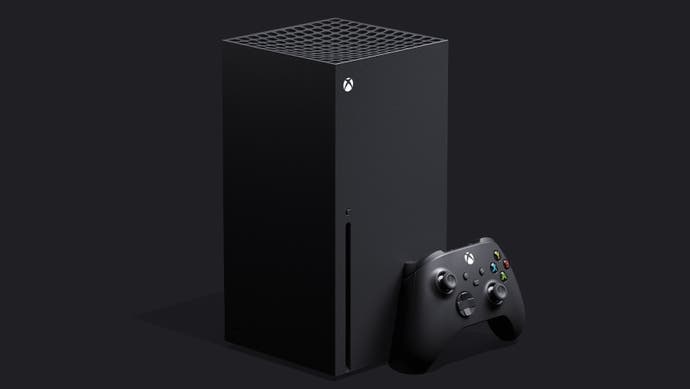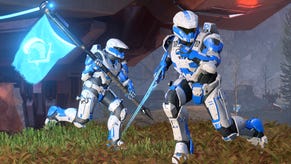The big interview: Xbox Series X development chief Jason Ronald on power, price and that new boot screen
"We've seen some things I did not think were possible."
Jason Ronald's job title is partner director of program management for the Xbox platform team, but what that somewhat robotic label boils down to is he's leading development of the Xbox Series X, Microsoft's next-generation console due out in time for Christmas 2020. He's played a key role in the making of the Xbox Series X, from the beginning to the present, its hardware to its software. Nobody knows Xbox Series X like Jason Ronald.
Ahead of Microsoft's reveal of some of the third-party games coming to the system, we had an extensive chat with Ronald to quiz him on everything from power to price, from concern over Xbox Series X games being constrained by having to work on the lowest common denominator (Xbox One), to the creation of the Xbox Series X's shiny new boot screen itself.
You have talked about obviously more powerful visuals for games, ray tracing, virtually instant loading. But does the Xbox Series X enable any sort of gameplay innovations we haven't seen before or are not possible on any other platforms?

Jason Ronald: The answer is kind of yes across the board. Obviously, with all the advances we have in GPU power and GPU efficiency, not only is it the raw power, but it's also the innovations on top of that, things like ray tracing for better lighting, better reflections, higher quality shadows, as well as more immersive audio experiences. You also have things like variable rate shading. Beyond the raw power we're delivering, we're giving developers a lot of tools to be that much more efficient in how they use t he power we're giving them.
But the real game changers from a gameplay and a game design perspective are actually on the CPU on the IO (data transfer speed) side. Today's current generation titles often are bottlenecked on the CPU on the IO side, and it's really constraining what you do as a game designer. And sometimes you have to arbitrarily change your creative vision to work within the constraints. But as you think about things like more and more open world games, more living, dynamic universes that players spend time in, we wanted to remove the technology barriers and enable developers to do super creative things. And really, that innovation is going to be on the CPU on the IO side. The CPU on the IO sides are also the areas that are usually least scalable from a game engine perspective.
So it was important to invest heavily there. For example, the introduction of the NVMe SSD as part of the Xbox velocity architecture. We designed the Xbox velocity architecture to be the ultimate solution for game asset streaming. And it works as an effective memory multiplier beyond the physical memory that's in the box because we have such superfast IO speeds, that there are entire classes of assets you don't even need to load into memory until just before you need them. So it opens up a whole swath of new capabilities for game developers.
In The Medium, as an example, there are certain things they are doing in that game, that they've had these ideas for many, many years, but it's just the technology was that barrier for them. And now with this next generation, those barriers don't exist. So they're able to provide true transformative gameplay experiences you would never be able to do on current generation or older generation consoles, because the technology was not at a point that allowed them to deliver on that.
Microsoft has talked about the framerates Series X will enable. But are you saying the Xbox Series X effectively ends sub 60 frames per second games, either from Xbox itself or from third-parties?
Jason Ronald: I wouldn't say it ends it, but now the creative control is in the developers' hands. Ultimately, we view resolution and framerate as a creative decision. Sometimes, from a pure gameplay aspect, 30 is the right creative decision they can make. But in previous generations, sometimes you had to sacrifice framerate for resolution. With this next generation, now it's completely within the developers' control. And even if you're building a competitive game, or an esports game, or a twitch fighter or first-person shooter, 60 frames is not the ceiling anymore. As we've seen on PC and other ecosystems, ultra high framerates and ultra low latency input, that is the precision they prefer to prioritise. So we've designed the system to put that creative control in developers hands.
Everything you've talked about makes the Xbox Series X sound incredibly powerful for a console, but I wince when I think about how much it's going to cost. What should people expect?
Jason Ronald: I think Phil [Spencer]'s been pretty transparent. We designed the system with a price point in mind. We're confident in the system we've designed, but at the same time, we're going to be agile on price.
The short of it is we designed the system with a price point in mind, and it influenced the overall architecture of the system we have. You know, it's kind of funny - as a lifelong gamer and as a game developer, we all always want more and more and more. At the same time, we know we have to deliver something at a compelling price point people all across the world are comfortable with and can afford. So it has been a key into the design of the system. And to be blunt, we're pretty excited about what we put into that form factor.
You'll have Xbox Series X for Christmas. What does this mean for Xbox One, Xbox Series S, Xbox One X, and potentially even more consoles? Aren't you creating a confusing offering for consumers? Will you discontinue any models to make the proposition clearer? What's your attitude running into the crucial Christmas period for that?
Jason Ronald: It'll become more clear as we get closer to launch. We don't think we're going to have a confusing SKU offering. But at the same time, we have tens of millions of people who have Xbox One consoles today. And we understand not everybody is going to choose to upgrade to the next generation immediately. We still have millions of players playing on Xbox 360 today as well. So what's important to us is we continue to support those ecosystems. Game developers will also continue to support both Xbox One and the Xbox Series X.
You know, I actually have both generations of consoles in my house. And it's important to me I can continue to play the games I want with the people I want on the devices I want. So I don't think it'll be a confusing SKU lineup or customer confusion. It's really about making sure our players have choice, and for our existing players, we provide an easy path for them to move forward if they choose to.
Given the fact all of your Xbox Series X games must work on a base Xbox One, does that not mean games will be hampered when it comes to design or fidelity because developers will have to develop to the lowest common denominator?
Jason Ronald: Ultimately, that's a developer choice. And to be clear, there will be titles that are unique or exclusive to the Xbox Series X generation. The Medium is a great example of that. But ultimately, this is going to be a choice each developer is going to have to make. And in some cases, they will choose to make games that are exclusive to the next generation.
The exact same tools you use to build a game on Xbox Series X, are the exact same tools you use to build a game on Xbox One, or on PC. So we've tried to make it as easy as possible for developers to ship their game across multiple devices, but then also to take advantage of the unique capabilities of the specific device that they're on.
As an example, you might have ray tracing enabled on the Xbox Series X optimised version of the game, but you don't have it enabled on the Xbox One version of the game. Or, you might have improved gaming experiences in some areas, and in other areas, you may choose to keep them the same. So I don't view it as a lowest common denominator. I view it as giving developers the tools they need to build the best gaming experience possible and developers are incentivised to make a great gaming experience for their players just like we are. It's about finding that right balance.
I know third-parties can decide to release games exclusive on Xbox Series X. But what about your own games? Take Halo Infinite for example. This is a game that works on a base Xbox One right up through to Xbox Series X. Obviously it'll look and perform better on Xbox Series X. But how can it have meaningful gameplay and design features that take advantage of what's possible on Xbox Series X when you have to make it work on a base Xbox One in fundamentally the same way?
Jason Ronald: In some ways, it's no different than some of the things we've been doing over the last couple of years with PC. We're focused on reaching the largest audience of players possible. And developers have a whole series of good techniques, whether it's things like dynamic resolution scaling as an example, that make it easier to scale up and scale down. Sometimes you'll have features that are exclusive to one device versus another.
All of these devices are shared from an Xbox Live perspective. So making sure people have great communities to play with, whether it's PC, Xbox One, Xbox Series X, we're giving developers the capability to have things that work similarly across generations, and that then lean into the unique capabilities of one form factor versus another.
What we've seen so far from both our first-party studios as well as third-party studios is they actually prefer this level of flexibility, because they know how to tailor their experience to provide that best experience for the player.
Now the specs of both the PlayStation 5 and Xbox Series X are out in the open, how do you feel about the direct comparison?
Jason Ronald: To be honest, we've always been super proud of what we've designed and built. Seeing some of the early results from developers... like we're really blown away by what we're seeing even at this early stage.
The thing that's most exciting is to see where this generation goes over the next three, five, seven, and 10 years. Because that's the thing: when you design and build a hardware platform, and a new console generation, you are setting the direction for the next decade of games. So what we're seeing so far at these early stages, we're super excited. And they're blowing us away. And I think it's gonna go even further as we get further into the generation.
From your perspective, how important is the teraflop debate, which I assume you're enjoying at the moment?
Jason Ronald: To me, it's about the end-to-end performance of the system. It's not one aspect versus another. What was critically important to us was sustained levels of performance, unlike anything you've seen before. And we designed the system to be a well balanced system with no bottlenecks or no compromises in any area... whether it's the CPU performance or the GPU performance - we were at the upper bounds of what was capable with a traditional rotational drive, so we knew we had to invest in things like SSD level IO performance. We designed the Xbox velocity architecture to be the ultimate solution for asset streaming.
What it comes down to is innovation and the integration between hardware and software. Look at something like the velocity architecture. That's a combination of the NVMe SSD, a dedicated hardware decompression block, a new file system API called Direct Storage, and then new innovation even on top of that called Sampler Feedback Streaming, which is what allows us to have an effective memory multiplier beyond what's in the physical memory. You also look at something like Variable Rate Shading. Not only do we have 12 teraflops of GPU power, but developers can be that much more efficient in how they use it. They can actually deliver results even beyond the raw teraflops that are in the box.
So to me it's more about how the system's used and the integration of hardware and software that will define what's possible in this next generation.
One of my biggest frustrations with the current generation of consoles is enormous and frequent download updates. I'm a big Call of Duty fan, and I'm constantly downloading massive updates to that game, which have effectively turned my console into my Call of Duty player. Is there anything about the Xbox Series X that mitigates that, or is that an impossible thing to do?
Jason Ronald: There is no single silver bullet that just makes games inherently smaller. But everything from the compression technologies we leverage, that actually allows the disc footprint and the amount of data you need to download to be smaller - we also give developers a lot of tools so they can be more intelligent about what assets get installed, and when. As an example, if you're on a console that is set to English, do I need to download the French and the Spanish audio assets or the cutscenes?
Also, two years ago now we also introduced a technology called Fast Start, where we can use machine learning to understand what assets are being used and how often they're being used, so we on the platform side can be more intelligent about what bits we install and when.
It is top of mind for us. It's something we work closely with all the industry middleware companies, as well as developers on, and then we provide a whole series of tools to help them drive the size of those games down not only to minimise the amount of content you need to download, but also the overall size on the actual footprint on disc.
It's definitely a challenge. It's definitely something we work hard on. But there's no easy button that just magically makes everything smaller. What we don't want to do is limit these amazing worlds and universes the game developers create. We just need to give them the tools to be able to make the right trade offs.
With Xbox Series X, do you have any file size or installation footprint limits you dictate to developers or even first-party studios to try to keep those down? Or are developers free to have their file sizes as big as they want?
Jason Ronald: Ultimately, we don't constrain it. The player experience dictates some of this stuff. How large is the game? How quickly can I get in there? How often do I take updates? How big are those updates?
We don't arbitrarily constrain the sizes, but players have made it clear, hey, here's what I'm willing to accept, and here's what I'm not willing to accept. Those things change over time. So once again, it's about providing the flexibility so we can be as sensitive as possible to players' bandwidth and hard drive sizes, so people get a great gaming experience without unnecessarily using more data or using more storage than they need to.
Can you confirm that's the Xbox Series X boot sequence you just put out this week?
Jason Ronald: I can confirm that is the Xbox boot animation.
Can you talk a bit about what you were going for with it? I think it's more chill than the Xbox One boot screen!
Jason Ronald: It's kind of funny you say chill! The word we used as we were developing it was elegant... premium. It's always an interesting part, because this is a new console generation. I love it. I've obviously been looking at it for quite a long time. It feels great when I turn on my Xbox Series X, and I actually get that moment.
How long did it need to be?
Jason Ronald: Ironically, this was one of the interesting design challenges we had. The Xbox Series X boots so fast there was an open question of how long does that boot animation need to be?
I will say it took a lot of iteration to figure out exactly what the right length was. Ultimately, what the console is doing is it's just booting. But it is quite funny - the design challenge of the console is so fast, we had to think uniquely, because we don't want to arbitrarily slow the console down. How do I build a boot animation for something that boots as fast as the console does?
It's funny - maybe the first time I played a game was on the Xbox Series X, and I don't even realise the game has load screens until I play it on a current generation console.
I can't imagine playing a game with no load times. Are you seriously saying that this is the end of loading?
Jason Ronald: You can never say the complete end of loading. But what I will say is, one of the key design principles we had is we wanted to remove all friction from the player's experience. How quickly does the console boot? How quickly can I get in a game? When I'm in a game experience, how do I make sure fast travel systems are actually fast and not just kind of like teleporting and then I get loading screens and stuff like that?
It's going to be interesting to see how developers take full advantage of these new capabilities. Because many of the games we're testing internally right now, were never designed for a system at the performance level that it has. So as you start thinking about games that are designed truly uniquely for these capabilities, I will just share that we've seen some things I did not even think were possible. I've seen these up and running already at the early stage of the console generation.
















.gif?width=291&height=164&fit=crop&quality=80&format=jpg&auto=webp)








